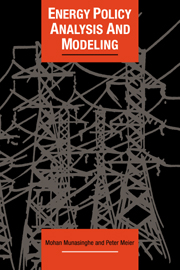Book contents
4 - Energy balances
Published online by Cambridge University Press: 05 March 2012
Summary
The basic tool of energy analysis is the energy balance table, which has long been used not just for presentation of historical statistics, but also as a means of presenting alternative views of the future. Table 4.1 illustrates the basic scheme: the columns of the table represent different energy forms – electricity, gasoline, and so on – and the rows of the table represent the different stages of energy production, transformation, and consumption. Thus for each column (fuel), the following identity must be satisfied:
Domestic production + imports − exports + stock changes − conversion inputs + conversion outputs = domestic consumption
Note the sign of certain rows: exports, losses, and inputs to energy conversion always have negative signs. It is of course possible to derive such future balances by purely manual means, bringing energy demand into balance with supplies and energy conversion facilities by iterative adjustment based on judgmental estimates of efficiencies, fuel allocations, the electricity generation mix, and so forth. Indeed, perhaps the most widespread use of LOTUS spreadsheets in LDC energy planning is for the presentation of energy balances, in which the spreadsheet performs only addition and tabular cross-checks, and all of the entries, even for future years, is essentially data, entered by hand. In many such spreadsheets the only rubrics estimated by spreadsheet formula are energy imports, which for small oil-importing developing countries without refineries are readily calculated as the residual.
Units
Although energy balances are often displayed in physical units (Kwh for electricity, tons for coal, etc.), for a number of reasons it is desirable to use a single unit.
- Type
- Chapter
- Information
- Energy Policy Analysis and Modelling , pp. 37 - 49Publisher: Cambridge University PressPrint publication year: 1993

